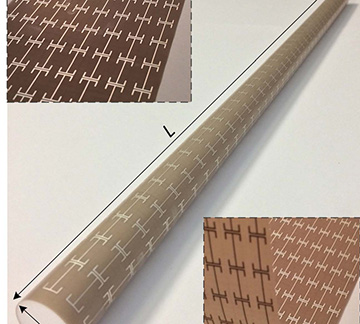
Rod-shaped waveguide with two quasi-two-dimensional conformal coatings that shield the waveguide from crosstalk and blocking and allow the waveguide to be smaller. [Image: Werner Lab, Penn State]
The smaller dielectric waveguides get, the more they tend to leak signals, creating undesirable crosstalk. Researchers at a U.S. university have demonstrated that two layers of precisely patterned conformal metasurface coatings can reduce crosstalk between these waveguides, so that the structures can be more easily miniaturized (Nat. Commun., doi: 10.1038/s41467-017-00391-0).
Power leak
The team at Pennsylvania State University began created subwavelength-sized circular rods—600 mm long and 25.4 mm in diameter—out of polytetrafluoroethylene (more commonly known by the trade name Teflon). The researchers then measured the normalized power distribution through the bare rod at microwave frequencies (2.8 to 4.0 GHz), and found that significant amount of the electromagnetic power lay outside the rod's core.
To increase the confinement of the electromagnetic modes, the researchers developed two layers of coatings made from a low-loss laminate derived from fiberglass. At 0.1 mm thick, the coatings were so thin compared with the rods that they acted almost like 2-D surfaces.
Guiding and cloaking
The inner coating, applied directly to the rod’s outer surface, had a metasurface pattern of capacitively coupled dipoles with a periodicity of 15 mm; it acted as a guiding layer for the microwave signals. The outer coating, with a metasurface pattern of dipoles somewhat less coupled than those of the inner coating, acted as a cloaking layer to suppress interference with other nearby guides operating at the same wavelength. Since waveguides in practice are often bundled together, it’s important to reduce their ability to interfere with each other's signals.
The Penn State researchers also experimented with twisting the pattern of the inner guiding coating and bending the bare and coated Teflon waveguides to a right angle. The guiding and cloaking layers continued to confine signals in the bent waveguide, whereas the bare waveguide exhibited severe leakage.
The signal control that the coatings give to the microwave-scaled waveguides could be scaled down to smaller dielectric waveguides for terahertz and perhaps even infrared frequencies, the authors suggest.
